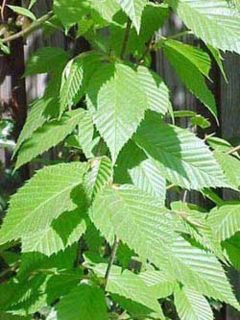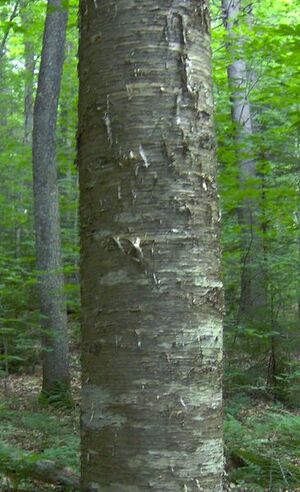Yellow Birch: Difference between revisions
No edit summary |
No edit summary |
||
| Line 1: | Line 1: | ||
{{SPlantbox | |||
|common_name=Yellow Birch | |||
|Temp Metric=°F | |||
|jumpin=If this plant info box on watering; zones; height; etc. is mostly empty you can click on the edit tab and fill in the blanks! | |||
|image=Upload.png | |||
|image_width=240 | |||
}} | |||
{{Inc| | {{Inc| | ||
Betula lutea, Michx. (B. excelsa, Pursh, not Ait.). Yellow Birch. Fig. 547. Tree, sometimes 100 ft.: bark silvery gray or light orange, on old trunks reddish brown; young bark aromatic, but somewhat bitter: branchlets usually rounded at the base, acuminate, sharply and doubly serrate, usually hairy along the veins beneath : cones like the last, but thicker; scales nearly ⅓in. long, lobed to the middle, pubescent outside. From Newfoundland west to Minn., south along the Alleghanies to the high peaks of N. C. and Tenn. S.S. 9:449. Em. 235. H.T. 126, 127.—One of the most valuable forest trees in the northern states, much resembling the former in habit. Var. persicifolia, Dipp., has larger and longer Lvs., often ovate-lanceolate. | Betula lutea, Michx. (B. excelsa, Pursh, not Ait.). Yellow Birch. Fig. 547. Tree, sometimes 100 ft.: bark silvery gray or light orange, on old trunks reddish brown; young bark aromatic, but somewhat bitter: branchlets usually rounded at the base, acuminate, sharply and doubly serrate, usually hairy along the veins beneath : cones like the last, but thicker; scales nearly ⅓in. long, lobed to the middle, pubescent outside. From Newfoundland west to Minn., south along the Alleghanies to the high peaks of N. C. and Tenn. S.S. 9:449. Em. 235. H.T. 126, 127.—One of the most valuable forest trees in the northern states, much resembling the former in habit. Var. persicifolia, Dipp., has larger and longer Lvs., often ovate-lanceolate. | ||
| Line 29: | Line 36: | ||
Yellow Birch is the [[Provincial tree emblems of Canada|provincial tree]] of [[Québec]], where it is commonly called ''merisier'', a name which in France is used for the [[wild cherry]]. | Yellow Birch is the [[Provincial tree emblems of Canada|provincial tree]] of [[Québec]], where it is commonly called ''merisier'', a name which in France is used for the [[wild cherry]]. | ||
The name | The name "yellow birch" reflects the color of the tree's bark. | ||
The wood of the yellow birch is extensively used for flooring, cabinetry and toothpicks. Most wood sold as ''birch'' in North America is from this tree. | The wood of the yellow birch is extensively used for flooring, cabinetry and toothpicks. Most wood sold as ''birch'' in North America is from this tree. | ||
Revision as of 15:57, 7 February 2010
| subsp. var. | Yellow Birch | |||||||||||||||||||||||||||||||||||||||||||||||||||||||
|---|---|---|---|---|---|---|---|---|---|---|---|---|---|---|---|---|---|---|---|---|---|---|---|---|---|---|---|---|---|---|---|---|---|---|---|---|---|---|---|---|---|---|---|---|---|---|---|---|---|---|---|---|---|---|---|---|

|
|
| ||||||||||||||||||||||||||||||||||||||||||||||||||||||
| ||||||||||||||||||||||||||||||||||||||||||||||||||||||||
| Standard Cyclopedia of Horticulture |
|---|
|
Betula lutea, Michx. (B. excelsa, Pursh, not Ait.). Yellow Birch. Fig. 547. Tree, sometimes 100 ft.: bark silvery gray or light orange, on old trunks reddish brown; young bark aromatic, but somewhat bitter: branchlets usually rounded at the base, acuminate, sharply and doubly serrate, usually hairy along the veins beneath : cones like the last, but thicker; scales nearly ⅓in. long, lobed to the middle, pubescent outside. From Newfoundland west to Minn., south along the Alleghanies to the high peaks of N. C. and Tenn. S.S. 9:449. Em. 235. H.T. 126, 127.—One of the most valuable forest trees in the northern states, much resembling the former in habit. Var. persicifolia, Dipp., has larger and longer Lvs., often ovate-lanceolate.
|
| Yellow Birch Fossil range: {{{fossil_range}}}
| ||||||||||||||||||||||||||||||||||||||||||||||||||||||||||||||||||
|---|---|---|---|---|---|---|---|---|---|---|---|---|---|---|---|---|---|---|---|---|---|---|---|---|---|---|---|---|---|---|---|---|---|---|---|---|---|---|---|---|---|---|---|---|---|---|---|---|---|---|---|---|---|---|---|---|---|---|---|---|---|---|---|---|---|---|
 Yellow Birch foliage | ||||||||||||||||||||||||||||||||||||||||||||||||||||||||||||||||||
| Plant Info | ||||||||||||||||||||||||||||||||||||||||||||||||||||||||||||||||||
| ||||||||||||||||||||||||||||||||||||||||||||||||||||||||||||||||||
| Scientific classification | ||||||||||||||||||||||||||||||||||||||||||||||||||||||||||||||||||
| ||||||||||||||||||||||||||||||||||||||||||||||||||||||||||||||||||
| [[{{{diversity_link}}}|Diversity]] | ||||||||||||||||||||||||||||||||||||||||||||||||||||||||||||||||||
| {{{diversity}}} | ||||||||||||||||||||||||||||||||||||||||||||||||||||||||||||||||||
| Binomial name | ||||||||||||||||||||||||||||||||||||||||||||||||||||||||||||||||||
| Betula alleghaniensis Britt. | ||||||||||||||||||||||||||||||||||||||||||||||||||||||||||||||||||
| Trinomial name | ||||||||||||||||||||||||||||||||||||||||||||||||||||||||||||||||||
| {{{trinomial}}} | ||||||||||||||||||||||||||||||||||||||||||||||||||||||||||||||||||
| Type Species | ||||||||||||||||||||||||||||||||||||||||||||||||||||||||||||||||||
| {{{type_species}}} | ||||||||||||||||||||||||||||||||||||||||||||||||||||||||||||||||||
| {{{subdivision_ranks}}} | ||||||||||||||||||||||||||||||||||||||||||||||||||||||||||||||||||
| [[Image:{{{range_map}}}|{{{range_map_width}}}|]] | ||||||||||||||||||||||||||||||||||||||||||||||||||||||||||||||||||
| Synonyms | ||||||||||||||||||||||||||||||||||||||||||||||||||||||||||||||||||
| {{{synonyms}}} |
Yellow Birch (Betula alleghaniensis, synomym B. lutea), is a species of birch native to eastern North America, from Nova Scotia, New Brunswick, and southern Québec west to Minnesota, and south in the Appalachian Mountains to northern Georgia.

It is a medium-sized deciduous tree reaching 20 m tall (exceptionally to 30 m) with a trunk up to 80 cm diameter. The bark is smooth, yellow-bronze, flaking in fine horizontal strips, and often with small black marks and scars. The twigs, when scraped, have a slight scent of oil of wintergreen, though not as strongly so as the related Sweet Birch. The leaves are alternate, ovate, 6-12 cm long and 4-9 cm broad, with a finely serrated margin. The flowers are wind-pollinated catkins 3-6 cm long, the male catkins pendulous, the female catkins erect. The fruit, mature in fall, is composed of numerous tiny winged seeds packed between the catkin bracts.
Yellow Birch is the provincial tree of Québec, where it is commonly called merisier, a name which in France is used for the wild cherry.
The name "yellow birch" reflects the color of the tree's bark.
The wood of the yellow birch is extensively used for flooring, cabinetry and toothpicks. Most wood sold as birch in North America is from this tree.